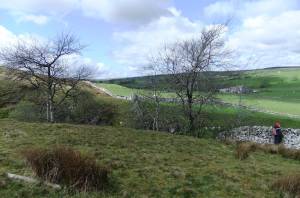|
| *****SWAAG_ID***** | 519 |
| Date Entered | 13/05/2012 |
| Updated on | 13/05/2012 |
| Recorded by | Tim Laurie |
| Category | Tree Site Record |
| Record Type | Botanical HER |
| SWAAG Site Name | |
| Site Type | |
| Site Name | |
| Site Description | |
| Site Access | Public Access Land |
| Record Date | 12/05/2012 |
| Location | Gilmonby CP Stainmore. Ravine at lower end of Hugill |
| Civil Parish | Not known |
| Brit. National Grid | NY 9770 1267 |
| Altitude | 304m |
| Geology | Chert strata overlying Great Limestone exposed in the stream cut gorge. |
| Record Name | Aspen Grove in Lower Ravine. Hugill. |
| Record Description | Aspen grove with trees of at least three generations on face of chert strata forming a sheer cliff above Hugill Beck at the lower end of the ravine below Hugill Force Waterfall.
At least one of the trees is multi-stemmed with three trunks springing from an ancient rootstock, see photo. Small willows and rowan grow with the aspens and a species rich Limestone Ashwood Community is present on the limestone below the aspens in the gorge cut by the stream. |
| Dimensions | See photos. |
| Geographical area | Stainmore |
| Species | Aspen |
| Scientific Name | Populus tremula |
| Common / Notable Species | Rowan, Sallow. |
| Tree and / or Stem Girth | |
| Tree: Position / Form / Status | |
| Tree Site ID | 0 |
| Associated Site SWAAG ID | 0 |
| Additional Notes | Aspen groves have been recognised at two localities further west on Sleightholme Beck and these two additional aspen groves below Hugill Force indicate that aspens were once more widespread across Stainmore.Individual aspen stems are not long lived but the colony or grove is self regenerating with young shoots or ramets springing from roots of ancestral trees. Accordingly it is probable that aspens have been present here since first colonisation of Britain by trees during the Early Post Glacial and Early Mesolithic Period some 10000-12000 years ago.
There is an association of Aspen with Juniper and this is seen in Upper Swaledale, however,
rather surprisingly,Juniper has not been recorded on Stainmore within the catchment of the Greta but is widespread in similar localities at the head of the Tees and the Tees Tributaries further North. |
| Image 1 ID | 2840 Click image to enlarge |
| Image 1 Description | Cloned aspens on chert strata exposed above the lower end of Hugill. |  |
| Image 2 ID | 2841 Click image to enlarge |
| Image 2 Description | Three aspen stems springing from an ancient rootstock. Individual aspen stems are not long lived but the colony or grove is self regenerating from the roots of ancestral trees. Accordingly it is probable that aspens have been present here since first colonisation of Britain by trees during the Early Post Glacial and Early Mesolithic Period some 10000-12000 years ago. |  |
| Image 3 ID | 2836 Click image to enlarge |
| Image 3 Description | The lower ravine and stream cut gorge below Hugill Force. |  |
| Image 4 ID | 2837 Click image to enlarge |
| Image 4 Description | Aspen trees at the top of the ravine. |  |
| Image 5 ID | 2838 Click image to enlarge |
| Image 5 Description | Aspen trees at the top of the ravine. |  |
| Image 6 ID | 2839 Click image to enlarge |
| Image 6 Description | The aspen Grove on chert strata exposed at the top of the east bank of the ravine |  |





